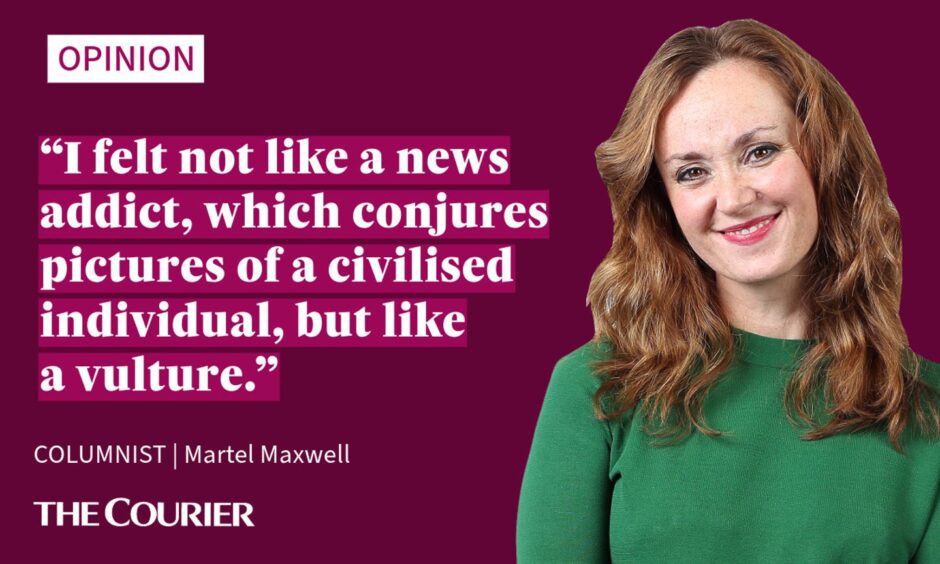My name is Martel and I’m a news addict.
Every morning is the same. I force myself to look out the window at the sky and not a screen for a moment.
Then I reach for my mobile phone for updates on three newspaper sites – The Courier and two nationals.
And that’s fine. For being a ‘news addict’ sounds ok – journalistic and inquisitive about the world, even.
But I questioned the self-administered term this week when, amidst the media storm in the aftermath of singer Liam Payne’s death, his ex partner and mother of his child Cheryl Cole, released a statement.

It contained a sentiment that made me stop and think. She asked people to respectfully remember that he wasn’t just a celebrity.
He was a real person – a friend, son, brother, uncle and father whose little boy would never see him again.
And I realised that while I – like so many – had been shocked and saddened to read the news of his death after falling from his hotel balcony, I had also disassociated myself from the humanity of it.
For even as I read the initial news, I was forming a column in my head – from the perspective of a mum and former showbiz reporter; of the many stars I’d seen who had found fame when still a teenager and struggled with the repercussions.
While that viewpoint is valid and I am a writer, not until I read Cheryl’s words did I really think about what had happened.
Of the injuries, the horror of having to fly to another country to see your son. Of explaining any if it to the seven-year-old son you both adored and welcomed into the world together. Of the gut-wrenching heartbreak of anyone who loved Liam, who they described as the kind of person who wanted to make you feel like the most special person in the room.
And here’s what made me feel slightly sick. That I – albeit along with millions of others, but still – had refreshed my news feed by the hour again and again, for more news after the story broke.
Looking for more detail, more information on what was the death of someone’s father and son.
And then, after Cheryl’s statement, I stopped scrolling, sickened by the thought of wanting to know more.
I felt not like a news addict, which conjures pictures of a civilised individual, but like a vulture. And no one wants to be a vulture.
Martel ‘felt like a vulture’
When you have such a realisation, you see it in almost every story.
Take the daily saga of rapper Kanye West and his wife Bianca Censori.
There we are, clicking on the latest picture of her on his arm, almost naked in public and shake our heads in disbelief – and zoom in to see if she’s wearing nude pants or nothing at all.
But she is a human being who is possibly (or possibly not) being made to wear not what she wants but what her husband tells her to; whose family have spoken out about their fears for her.
Then consider that being you – made to show your almost naked self walking down Reform Street. Riveting news, or gross exploitation and domestic abuse that will scar you for life? And if that’s what we see, what happens behind closed doors?
As the dark nights draw in, it’s perhaps a time for introspection and occasionally, a movie or series will make you think.
For me, at the weekend, it was the biographical film Back to Black about the late singer Amy Winehouse.
While some criticise it for white-washing her ex-husband Blake Fielder-Civil’s role in her spiralling addictions, it is also a magnificent movie – the portrayal of Amy by the actress Marisa Abela, astonishing.
On this note and actress, if you’re looking for a series to get stuck into, I cannot recommend Industry on BBC iplayer enough – so long as you don’t mind your evening watching rather spicy and at times dark.
Created by former bankers Mickey Down and Konrad Kay, it follows the lives of young graduates in the high end world of banking in London and also features Marisa as its break-out star. She is so watchable – the type of performer who comes along once in a decade and has you unable to lift your eyes from the screen.
Back to the story of Amy’s life. It portrays beautifully the fact that, like Liam, she was living two lives. That of singer and celebrity but also of a human with flaws, addictive predispositions and dark times.
Her life too ended in tragedy prematurely, from alcohol poisoning aged 27 after a prolonged period of staying sober.
It’s possible to be moved, to care or even want to know more about anyone, celebrity or not.
But – and I’m speaking for myself here – it is also possible to cross a line – or choose not to.
For, once crossed, it makes us more vulture and less human ourselves.




Conversation